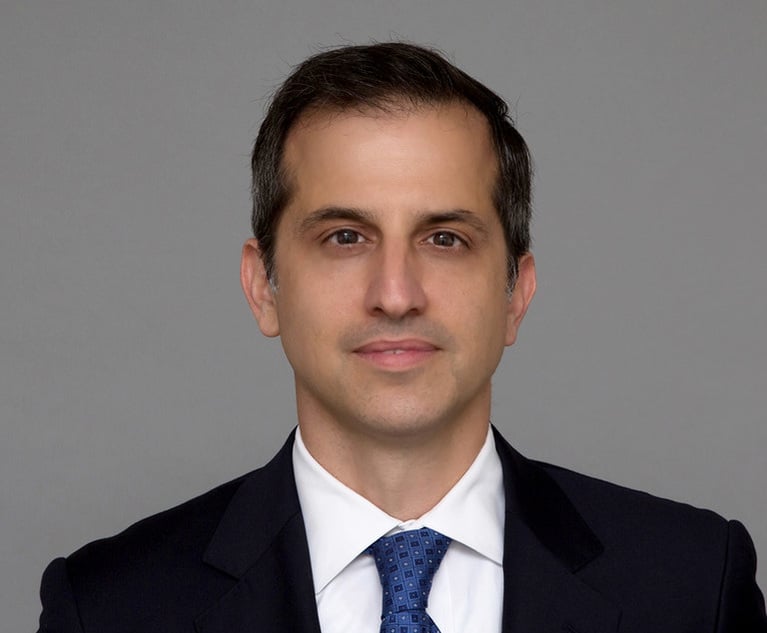'Once I Get Going…' Is Not Good Enough
"Hand movements, even those initial tiny impulses, occur on important words. Emphatic gestures lead to emphatic speech. That is why listeners often respond with, 'I hear what you're saying,'" writes courtroom communications expert Brian K. Johnson.
February 12, 2020 at 09:52 PM
7 minute read
 Business people talking.
Business people talking.
If you are already an experienced and persuasive oral advocate, take up this challenge to be even better. Explore your relationship to the expression: "Once I get going…"
I've heard that phrase uttered by advocates more than any other. It's inevitably followed by some positive self-analysis: "Once I get going, I'm really good!" "Once I get going, I find my rhythm." "Once I get going, I slip into that zone of concentration." Even inexperienced advocates confess, "Once I get going, it's not so bad!" or "Once I get going, I really like it!"
The big secret embedded in this little phrase involves your brain's motor cortex, your initial adrenaline rush, and the surprising science that connects how you think, speak, and gesture. Once you understand this, you can reverse-engineer the neuroscience and use it to your advantage. So, give yourself an edge, take your delivery skills to the next level, and be your best from the first sentence. Once you get going is not good enough.
The phrase itself begs the question: What goes once you get going? You can see it and hear it, if you know where to look and how to listen for it. The answer begins with the mystery of your unconscious, natural gestures, but it extends well beyond hand gestures to include how you think, speak, and feel.
As speakers get going, hand gestures typically progress incrementally through a series of changes. There is a reason we compliment good speakers by referring to them as smooth. Once you get going, your gestures become smoother and larger, but they may not start that way.
Initial gestures are often small and jerky. These tiny actions aren't gestures at all, but merely the inhibited impulse to gesture, revealed by twitches of the index fingers and thumbs, or spasms of the wrists or forearms. These impulses hint that the speaker will eventually gesture naturally, but only once she gets going, which will take about two uncomfortable minutes.
Adrenaline is partly to blame. When the body perceives performance pressure as a threat, adrenaline targets the arm muscles to fight and the legs to flee. The rush lasts a couple of minutes before it dissipates. That adrenalized energy at the beginning is why knees knock and fingers sometimes tremble.
When gesturing casually in everyday conversation, the arms have a reflexive instinct to gesture loosely and smoothly. None of this action is mitigated by conscious awareness or choice. This explains why we sometimes say, 'I felt comfortable because I was loose.' Or alternatively, 'I felt uncomfortable because I was tight.' If you're skeptical that your conversational gestures are big, loose, and smooth, begin to pay attention to them.
During an adrenaline rush the arm muscles mobilize to fight, but they stay close to protect the body. Think of a prize-fighter in the ring with his gloves held defensively right in front of his body. When adrenaline is flowing, expansive natural gestures feel too big, too open, and too vulnerable. You could get hurt! So, the body tries to protect itself. Once the fight-or-flight hormone dissipates, gestures loosen up and get going because the body senses that the threat has diminished, so it's now okay to open up and gesture more freely. If you want to get going immediately, gesture bigger and smoother from your first sentence.
Gestures aren't so important in and of themselves, because no one is focused directly on your hands. Gestures are a means to the end of looking, sounding, and feeling like yourself. Dr. David McNeill, emeritus professor at the University of Chicago, is one of the world's preeminent gesture experts. His book titled, "Why We Gesture: The Surprising Role of Hand Gestures in Communication," contains some nuggets of wisdom.
McNeill describes "a gesture/speech unity." In other words, you don't just wave your arms around when you gesture. Your gestures illustrate what your words mean. That's why listeners say, "I see what you mean." What they see are the gestures that accompany your words.
Coincidentally, William Shakespeare said precisely the same thing 400 years ago when he described the logic of natural gestures: "Suit the action to the word, and the word to the action." If you want the fact finder to see what you're talking about, once you get going is two minutes too late to get them visually engaged.
Gestures have another persuasive function. In addition to the gesture/speech unity, McNeill's research establishes that your "gestures orchestrate speech." In other words, only when you gesture like yourself, do you sound like yourself. Hand movements, even those initial tiny impulses, occur on important words. Emphatic gestures lead to emphatic speech. That is why listeners often respond with, I hear what you're saying. Even a blind listener benefits from gestures because they affect the intonation, inflection, and rhythm of speech.
The next time you hear a boring, monotone speaker, look at their hands. They never gesture. The lack of gestures leads to a lack of vocal expression. When we gesture as we speak in conversation, we embody both a choral conductor and a choir. Our expressive hand movements lead to expressive music making. (If you find that surprising, watch television while observing hands, not faces, and listening to words.) You want the fact finder to hear what you're saying, so gesture immediately to sound like your persuasive self, not two minutes later once you get going.
Here's the final good news. You are already the world's expert at how to you naturally gesture. Don't think about it too much and over-intellectualize your gestures. Trust your own instinct to gesture. Here are a few practical techniques to get going immediately:
First, tell yourself: Be ready to gesture.
Raise your hands to about waist height, loosely touching in a "ready position," as if you're ready to catch a ball.
Resist the urge to rest your hands on a lectern or hold a pen. Don't put your hands behind your back, in your pockets, or below your waist. Gestures flow more easily from the ready position.
Tell yourself to be smooth as you begin to gesture, like a tennis pro or a golf pro would tell an athlete to smoothly swing of a racket or club.
Keep your hands about body-width apart when you start to gesture, avoiding the adrenaline-induced impulse to stay tight.
Turn your palms upward in a gesture of giving, as you give the facts, or give your argument, or give a witness a question.
If you tell yourself to be ready and be smooth, you will likely get going immediately. First impressions matter, so be your most persuasive from the get-go.
Brian K. Johnson works one-on-one with hundreds of attorneys each year to help them analyze and improve their communication skills. He trains for the Department of Justice and elite law firms throughout the United States. He is an award-winning co-author of The Articulate Advocate: Persuasive Skills for Lawyers in Trials, Appeals, Arbitrations, and Motions and The Articulate Attorney: Public Speaking for Lawyers—recently made available as audiobooks.
This content has been archived. It is available through our partners, LexisNexis® and Bloomberg Law.
To view this content, please continue to their sites.
Not a Lexis Subscriber?
Subscribe Now
Not a Bloomberg Law Subscriber?
Subscribe Now
NOT FOR REPRINT
© 2025 ALM Global, LLC, All Rights Reserved. Request academic re-use from www.copyright.com. All other uses, submit a request to [email protected]. For more information visit Asset & Logo Licensing.
You Might Like
View All
Firms Come Out of the Gate With High-Profile Litigation Hires in 2025

2024 Marked Growth On Top of Growth for Law Firm Litigation Practices. Is a Cooldown in the Offing for 2025?

Big Company Insiders See Technology-Related Disputes Teed Up for 2025

Litigation Leaders: Jason Leckerman of Ballard Spahr on Growing the Department by a Third Via Merger with Lane Powell
Trending Stories
- 1Thursday Newspaper
- 2Public Notices/Calendars
- 3Judicial Ethics Opinion 24-117
- 4Rejuvenation of a Sharp Employer Non-Compete Tool: Delaware Supreme Court Reinvigorates the Employee Choice Doctrine
- 5Mastering Litigation in New York’s Commercial Division Part V, Leave It to the Experts: Expert Discovery in the New York Commercial Division
Who Got The Work
J. Brugh Lower of Gibbons has entered an appearance for industrial equipment supplier Devco Corporation in a pending trademark infringement lawsuit. The suit, accusing the defendant of selling knock-off Graco products, was filed Dec. 18 in New Jersey District Court by Rivkin Radler on behalf of Graco Inc. and Graco Minnesota. The case, assigned to U.S. District Judge Zahid N. Quraishi, is 3:24-cv-11294, Graco Inc. et al v. Devco Corporation.
Who Got The Work
Rebecca Maller-Stein and Kent A. Yalowitz of Arnold & Porter Kaye Scholer have entered their appearances for Hanaco Venture Capital and its executives, Lior Prosor and David Frankel, in a pending securities lawsuit. The action, filed on Dec. 24 in New York Southern District Court by Zell, Aron & Co. on behalf of Goldeneye Advisors, accuses the defendants of negligently and fraudulently managing the plaintiff's $1 million investment. The case, assigned to U.S. District Judge Vernon S. Broderick, is 1:24-cv-09918, Goldeneye Advisors, LLC v. Hanaco Venture Capital, Ltd. et al.
Who Got The Work
Attorneys from A&O Shearman has stepped in as defense counsel for Toronto-Dominion Bank and other defendants in a pending securities class action. The suit, filed Dec. 11 in New York Southern District Court by Bleichmar Fonti & Auld, accuses the defendants of concealing the bank's 'pervasive' deficiencies in regards to its compliance with the Bank Secrecy Act and the quality of its anti-money laundering controls. The case, assigned to U.S. District Judge Arun Subramanian, is 1:24-cv-09445, Gonzalez v. The Toronto-Dominion Bank et al.
Who Got The Work
Crown Castle International, a Pennsylvania company providing shared communications infrastructure, has turned to Luke D. Wolf of Gordon Rees Scully Mansukhani to fend off a pending breach-of-contract lawsuit. The court action, filed Nov. 25 in Michigan Eastern District Court by Hooper Hathaway PC on behalf of The Town Residences LLC, accuses Crown Castle of failing to transfer approximately $30,000 in utility payments from T-Mobile in breach of a roof-top lease and assignment agreement. The case, assigned to U.S. District Judge Susan K. Declercq, is 2:24-cv-13131, The Town Residences LLC v. T-Mobile US, Inc. et al.
Who Got The Work
Wilfred P. Coronato and Daniel M. Schwartz of McCarter & English have stepped in as defense counsel to Electrolux Home Products Inc. in a pending product liability lawsuit. The court action, filed Nov. 26 in New York Eastern District Court by Poulos Lopiccolo PC and Nagel Rice LLP on behalf of David Stern, alleges that the defendant's refrigerators’ drawers and shelving repeatedly break and fall apart within months after purchase. The case, assigned to U.S. District Judge Joan M. Azrack, is 2:24-cv-08204, Stern v. Electrolux Home Products, Inc.
Featured Firms
Law Offices of Gary Martin Hays & Associates, P.C.
(470) 294-1674
Law Offices of Mark E. Salomone
(857) 444-6468
Smith & Hassler
(713) 739-1250






